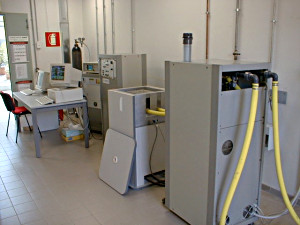1996 - 1999 : CONTRAST-ENHANCED MAGNETIC RESONANCE ANGIOGRAPHY (MACE)
Contract: BMH 4960051
Partners:
- Université de Mons Hainaut, Faculté de Médecine, Dép.Chimie Organique, Prof. Robert N. Müller (Coordinator)
- Università degli Studi di Torino, Dip.Chimica Inorganica, Chimica Fisica e Chimica dei Materiali, Prof. Silvio Aime
- Technische Universiteit Delft, Fakulteit Scheikundige Technologie en Materiaalkunde, Dr.Ir. Joop A. Peters
- Stelar, Mede (Italy), Dr. Stanislav Sykora
- University of Oslo, Faculty of Mathematics and Exact Sciences, Dep.Medicinal Chemistry, Prof. Jo Klaveness
- Universidade de Coimbra, Dep.Zoologia, Prof. Carlos F.G.C. Geraldes
- Universität Basel, Institut für Diagnostische Radiologie, Pd.Fr. Georg M. Bongartz
- Université de Lausanne, Institute of Inorganic and Analytical Chemistry, Prof.Dr. André E. Merbach
- Nycomedimaging AS, Mr. Per Strande
Project overview based on the initial application:
Objectives: The objective of the proposed project is the theoretical design, development, synthesis, and preclinical testing of improved high molecular weight paramagnetic complexes and nanoparticles resulting in positive perfusion agents. These compounds should remain almost exclusively in the intravascular space, selectively display the blood vessels, and be safely excreted preferably through the kidneys. They should possess a Tl relaxivity one or two orders of magnitude higher than those of low molecular weight gadolinium contrast agents. The main improvements over existing contrast agents are to be done in relaxivity, specificity, intravascular residence time, and biodistribution.
General Information: The project will cover the synthesis and the characterization of new magnetic blood pool agents. This research will be twofold: on the one hand the efficiency (relaxivity) of the magnetic centre will be fine tuned by an extensive study of the factors governing the magnetic interactions between the water protons and the electron-rich centre and on the other hand the nature of the macromolecular (or particulate) carrier will be carefully examined in order to achieve the best blood half-life and guarantee the absence of any toxic effect. Among the microscopic parameters to be studied in the context of relaxivity improvement are the water exchange time between the magnetic centre and the bulk (tm) the field dependence of the electronic relaxation time (ts) and the molecular tumbling rates (tr). In particular the relationships between these factors and the molecular structure will be systematically studied and the influence of covalent and non-covalent binding to large size carriers will be evaluated.
This project involves two industrial partners. While a dedicated NMR field cycling instrumentation suited for routine relaxivity studies at medium and low fields will be developed with the first one, the collaboration with the other partner belonging to the pharmaceutical world will concern the evaluation of the in-vivo properties.
|
1996 - 2000 : FIELD CYCLING NMR RELAXOMETRY
Contract: ERB FMGE CT95 0002
Partners:
- SON NMR LSF, Utrecht University, Prof. Robert Kaptein (Coordinator)
- CIRMMP, University of Florence, Prof. Ivano Bertini (Contract Manager)
- UNIFRA NMR (now BMRZ), Johann Wolfgang Göthe Universität, Frankfurt, Prof. Heinz Rüterjans
- STELAR, Mede (Italy), Dr. Stanislav Sykora
Project overview according to the initial application:
NMR fast field cycling (FFC) relaxometer is a unique method of measuring the longitudinal nuclear magnetic relaxation times (T1) at varying magnetic field strengths. The T1 dispersion curves are at present used in basic and applied research in biochemistry and biology as well as in other fields like medial diagnostics and material sciences. There is an excellent application potential wherever the desired characteristics of a material depend intimately upon its molecular dynamics and/or aggregation state.
 The present application combines:
The present application combines:
1) the technological expertise offered by a company with many years of experience in the field of instrumental measurements of nuclear relaxation parameters;
2) the complementary expertise of three large laboratories in the field of theory and applications of relaxation to the understanding of structural and dynamic properties of biological macromolecules.
This is a unique combination of know-how and interest. Our objective is the development of an FFC relaxometer which will
a) combine reasonable operating costs with high sample throughput
b) combine ease of use with research-grade versatility
c) permit the measurement of cross relaxation time dispersion profiles.
A prototype of the FFC relaxometer under development will be made available at an early stage in one of the facilities associated in the cluster. The prototype will be used as a benchmark for testing theories and novel applications. It is expected that this activity will produce a very effective real-time feedback for the successive technological development.
|
|